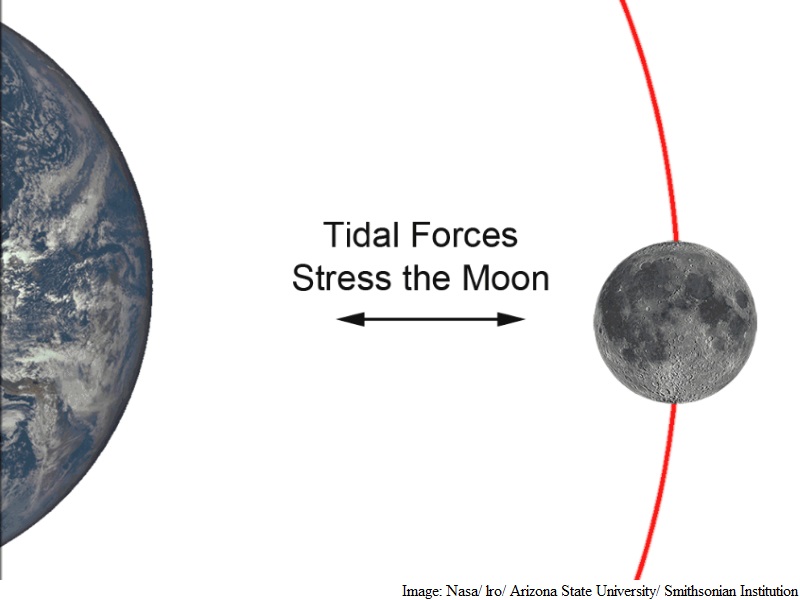- Home
- Science
- Science News
- Earth's Gravitational Pull Is 'Massaging' the Shrinking Moon
Earth's Gravitational Pull Is 'Massaging' the Shrinking Moon

After more than six years in orbit, the US space agency's Lunar Reconnaissance Orbiter has imaged nearly three-fourths of the lunar surface at high resolution, allowing the discovery of over 3,000 faults.
These globally distributed faults have emerged as the most common tectonic land form on the moon.
An analysis of the orientations of these small scarps yielded a surprising result.
The faults, created as the moon shrinks, are being influenced by an unexpected source gravitational tidal forces from Earth.
Global contraction alone should generate an array of thrust faults with no particular pattern in the orientations of the faults, because the contracting forces have equal magnitude in all directions.
"But there is a pattern in the orientations of the thousands of faults and it suggests something else is influencing their formation, something that is also acting on a global scale 'massaging' and realigning them," explained Smithsonian senior scientist Thomas Watters from the National Air and Space Museum in Washington, DC.
The gravitational forces the Moon and Sun exert are responsible for Earth's rising and falling tides. Similarly, Earth's gravity also exerts forces on the Moon in the form of solid body tides that distort its shape.
The Moon is slowly receding away from Earth and forces build as the Moon's tidal distortion diminishes with distance and its rotation period slows with time.
The fault scarps are very young so young that they are likely still actively forming today.
The team's modelling shows that the peak stresses are reached when the moon is farthest from Earth in its orbit.
If the faults are still active, the occurrence of shallow moonquakes related to slip events on the faults may be most frequent when the moon is at apogee.
This hypothesis can be tested with a long-lived lunar seismic network.
"The LRO data set enables us to tease out subtle but important processes that would otherwise remain hidden," noted John Keller, LRO project scientist at Nasa's Goddard Space Flight Center, Greenbelt, Maryland, in a paper published in the journal Geology.
Launched on June 18, 2009, LRO has collected a treasure trove of data with its seven powerful instruments, making an invaluable contribution to our knowledge about the moon.
For the latest tech news and reviews, follow Gadgets 360 on X, Facebook, WhatsApp, Threads and Google News. For the latest videos on gadgets and tech, subscribe to our YouTube channel. If you want to know everything about top influencers, follow our in-house Who'sThat360 on Instagram and YouTube.
Related Stories
- Amazon Great Indian Festival 2024
- Big Billion Days 2024
- Apple Vision Pro
- Oneplus 12
- iPhone 14
- Apple iPhone 15
- OnePlus Nord CE 3 Lite 5G
- iPhone 13
- Xiaomi 14 Pro
- Oppo Find N3
- Tecno Spark Go (2023)
- Realme V30
- Best Phones Under 25000
- Samsung Galaxy S24 Series
- Cryptocurrency
- iQoo 12
- Samsung Galaxy S24 Ultra
- Giottus
- Samsung Galaxy Z Flip 5
- Apple 'Scary Fast'
- Housefull 5
- GoPro Hero 12 Black Review
- Invincible Season 2
- JioGlass
- HD Ready TV
- Laptop Under 50000
- Smartwatch Under 10000
- Latest Mobile Phones
- Compare Phones
- Vivo Y18t
- Honor X9c
- Honor Magic 7 Pro
- Honor Magic 7
- Sharp Aquos R9 Pro
- Xiaomi 15
- Xiaomi 15 Pro
- Redmi A3 Pro
- Asus Zenbook S 14
- MacBook Pro 16-inch (M4 Max, 2024)
- Huawei MatePad 11.5
- Acer Iconia Tab 10.36 (iM10-22)
- Redmi Band 3
- Xiaomi Smart Band 9 Pro
- Sony 65 Inches Ultra HD (4K) LED Smart TV (KD-65X74L)
- TCL 55 Inches Ultra HD (4K) LED Smart TV (55C61B)
- Sony PlayStation 5 Pro
- Sony PlayStation 5 Slim Digital Edition
- Acer 1.5 Ton 5 Star Inverter Split AC (AR15AS5INGMA)
- Daikin 1.5 Ton 4 Star Inverter Split AC (FTKT50UV16V+RKT50UV16V)

















